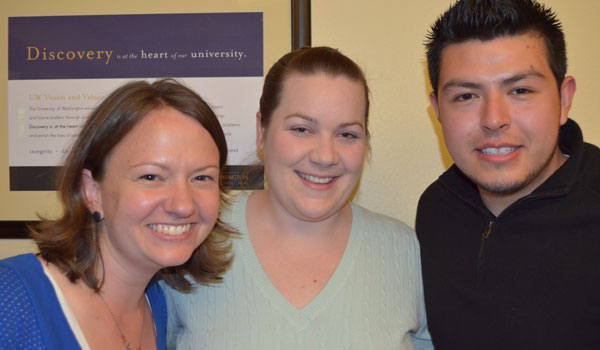Drinking fountains. Broken glass. Asbestos in the ceiling. A basketball court. These were some of the things a group of high school students noticed as they conducted a public health "scavenger hunt" around their school. Some things were good for their health. Others were not.

Sara Colling, teacher Alicia Emsley and undergraduate Jose Gaona took part in a pioneering program to teach high school students about public health.
The exercise was a way for the teachers – six undergraduates from the University of Washington School of Public Health – to help the high school students understand the complex factors affecting health. In this case, the lesson was about the importance of the built environment to the health of communities.
The unique training program brought together undergraduates, high school students, a graduate student and a health department. It was spearheaded by Sara Colling as part of a requirement to earn her master's degree through the School's Community-Oriented Public Health Practice program. And it was made possible by a first-year teacher, Alicia Emsley, of the Highline School District's Health Sciences & Human Services High School south of Seattle.
"The purpose was to engage students in equity and social justice through public health," said Colling. Public Health – Seattle & King County provided the initial connections and brought guest speakers to Emsley's three classes. The project reached 77 ninth-graders.
The six UW undergraduates taught as part of a pilot service-learning program at the School of Public Health. From now on, all students majoring in public health will be required to take a two-quarter "capstone" course designed to synthesize all they have learned from their courses with 50 hours of community service. The idea is to provide a culminating experience that helps students better understand the communities they've been studying, said Deb Hinchey, the capstone instructor.
At the Highline school, the undergraduates focused on teaching the "social determinants of health" – the conditions in which people are born and raised; where they live, work and go to school; and the objects and forces around them. Those determinants include factors such as race, income, neighborhood design and access to health care. Emsley said the concepts are abstract for most of her ninth-graders, but that UW undergraduates were able to break them down into specific examples. "They would bring in a lot of different perspectives and real-world experiences," she said.
"We helped create public health awareness and we really focused on social determinants," said Jessica Wong, a UW undergraduate.
Besides the scavenger hunt, students took part in a game called "Lay it on the Line." Each student was given a character to play and assigned skin color, gender and social-economic status. The different variables meant they had to take one step forward or one step backward, and where they ended up was a sign of their overall health. Affluent white males were at one end, while women of color were at the other. "They ended up far apart on the line," Colling said, "not because of their own choices, but because of the system."
The health sciences high school, known as "HS3," uniquely teaches through a health lens; students are prepared for future careers in health. Latino and Asian/Pacific Islanders make up the majority of its student body, and more than 82 percent of students qualify for the free-or reduced-lunch program.
The project also gave UW undergraduates the experience of teaching and engaging with the community. "I was able to apply my public health classes to a real-life population," said Jessica Wong, a UW senior majoring in public health and communication. "We helped create public health awareness and we really focused on social determinants. One of our main goals was for the students to be able to recognize what part of their environment effected their health, and I believe we were very successful in doing so as a group."
Another UW student, Willada Loch, said, "Working within the community allowed me to solidify the idea of how our communities can make it easier or harder to make healthy choices." Other undergraduates who took part were Pooja Bhatt, Christine Dinh, Jose Gaona and Elizabeth McQuade.
Said Colling: "That was a super-rewarding part of the whole thing. I got to watch them grow as health-educators. They gained really concrete skills and I think it really reinforced what they were learning at courses at the UW."
According to Colling, 24 of the 55 high school students who filled out a post-course survey said they could see themselves going into a career in public health, while 18 of the students answered "maybe" – results she termed "encouraging."
Said Emsley, "This really opened their eyes to other ways of being involved in the health sciences community without being a doctor or a nurse – for example, they could work for a county, become paramedics or food safety inspectors."
Emsley received the School of Public Health's annual Community Partner Award for her collaboration on this project. The School, meanwhile, is planning to expand the program to two more high schools.
